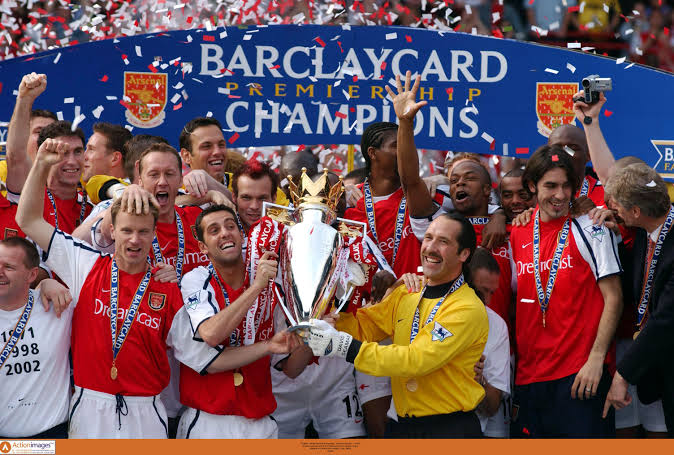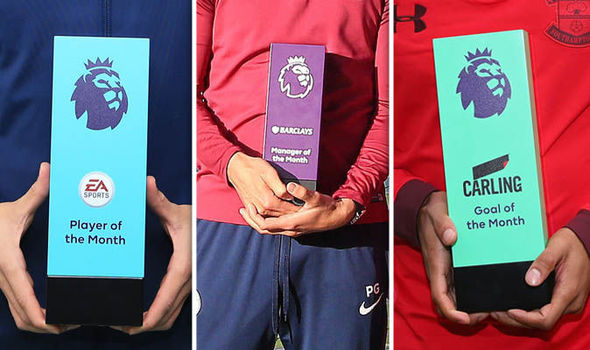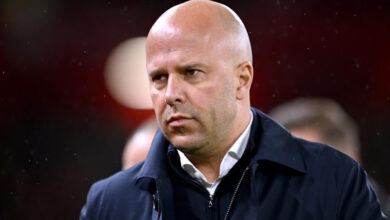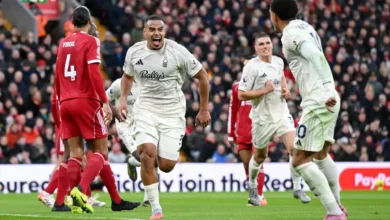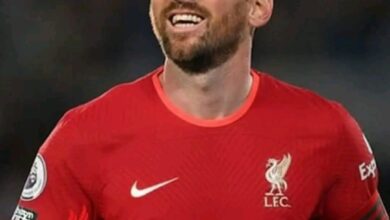Erling Haaland reported to police after ‘hitting club mascot on back of her head
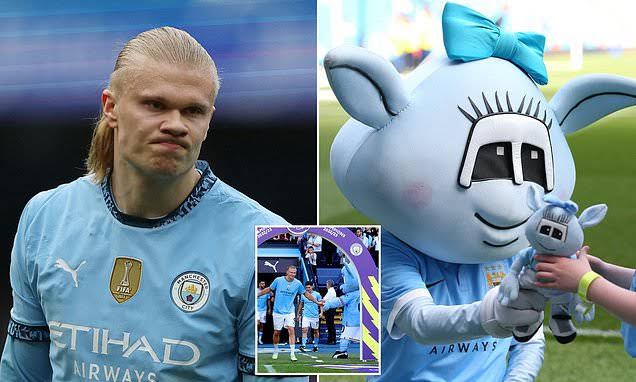
Erling Haaland, the star striker for Manchester City, has been making waves in the world of football due to his remarkable performances on the pitch. However, his involvement in an off-field incident in March 2025 brought his name into the headlines for reasons other than his footballing prowess. Haaland, widely regarded as one of the most talented and lethal forwards in Europe, was involved in an event that left a club mascot injured and led to the woman filing a police report. The incident took place before a match against Southampton, an encounter that would see Haaland score the only goal of the game, securing a crucial win for Manchester City. Despite this, it was his interaction with the club’s mascot, “Moonbeam,” that sparked controversy.
The woman involved in the incident was working as Manchester City’s alien mascot, Moonbeam, during the match. Her role was to entertain fans before and during the game, representing the club in a light-hearted, fun manner. Mascots are often seen as a way for football clubs to engage with their supporters, providing a sense of joy and humor, especially to children. It’s not an easy job, requiring the mascot to interact with fans, pose for photos, and embody the spirit of the club. This particular woman, in addition to her mascot duties, also worked in the ticket office at the club, making her role both varied and essential to the matchday experience.
However, the woman’s day would take a sudden and unexpected turn during her shift as Moonbeam. According to reports, the incident occurred just before the match against Southampton. Haaland, in what was described as a playful interaction, reportedly struck her on the back of the head. Initially, the woman thought that she had been hit by a stray football, which is not uncommon during pre-match activities. However, as it became clear that it was Haaland who had struck her, she was left stunned and in shock. The blow caused her to experience significant physical pain, and she was eventually taken to the hospital for treatment. The woman was left with suspected whiplash and concussion, injuries that require serious medical attention.
In the aftermath of the incident, the woman took immediate action. She reportedly complained to Manchester City, expressing her concerns about the incident and its impact on her. Additionally, she filed a formal assault complaint with the police. It’s not clear exactly why Haaland hit her or if it was intentional, but the woman’s complaint suggested that the blow was more than just a playful tap. In her view, it was a serious matter that needed to be addressed, leading to her decision to involve law enforcement.
The club responded quickly, with a spokesperson commenting on the situation. Manchester City undertook a thorough investigation into the incident, looking at all available evidence, including video footage from the matchday. The investigation did not find any evidence to support the woman’s claim that the injury had occurred in the way she described. The video footage, as well as other evidence, appeared to show that the incident may not have been as severe as initially claimed. Despite this, the club did not dismiss the woman’s experience outright, instead taking the time to review all information before making a final judgment. According to the club’s spokesperson, the evidence did not back up the assertion that the injury had occurred in the manner that was alleged by the mascot.
Moreover, Manchester City was aware that a formal complaint had been lodged with the Greater Manchester Police. The police conducted their own investigation into the incident, but after reviewing the case, they decided not to take further action. This decision was made after considering all available evidence, including witness statements and the results of the club’s investigation. The police found no reason to pursue any charges or further inquiries, effectively closing the case. While the woman may have felt that the incident warranted legal attention, the police and the club ultimately concluded that there was no need for any further legal action.
While the investigation and its conclusion may have satisfied the club and the police, the incident became a topic of public interest due to the involvement of such a high-profile player like Haaland. As one of the biggest stars in world football, Haaland’s every move is closely watched by the media and fans alike. His actions off the pitch often attract as much attention as his performances on it. This particular event, which occurred just before a match against Southampton, added to the drama surrounding the player’s public image, especially when it was revealed that the incident had led to the mascot being hospitalized.
The match itself was significant for Manchester City, as they were coming off a solid run of form in the Premier League. Haaland’s goal in the fifth minute was enough to secure a 1-0 victory over Southampton, a crucial win that helped keep City in contention for the league title. At the time, the team was on a three-match winning streak, and the victory over Southampton marked another step toward maintaining their momentum in the competition. Haaland, who had been in exceptional form throughout the season, was the hero of the match, scoring the only goal of the game. His performance, as always, was a testament to his incredible goal-scoring ability, a skill that had made him one of the most sought-after players in the world.
However, despite the importance of the win, the news of the incident involving Haaland and the mascot quickly overshadowed the footballing aspect of the day. The incident occurred at a time when Manchester City was striving to maintain its strong form in the Premier League, but the controversy surrounding Haaland and the club’s mascot left many questioning the player’s actions. Although the investigation by the club and the police cleared Haaland of any intentional wrongdoing, the incident still raised concerns about player behavior and interactions with staff and mascots. Many fans and commentators began to discuss the broader implications of such incidents, asking whether there needed to be more awareness and sensitivity surrounding players’ conduct, even during playful interactions.
Haaland’s behavior was not the only topic of discussion at Manchester City during this period. The Norwegian forward had signed a remarkable nine-and-a-half-year contract with the club in January, a deal that was one of the most lucrative and long-term in modern football. This contract signified Haaland’s commitment to Manchester City, a move that shocked many in the footballing world. Most players in Haaland’s position, particularly at such a young age, typically sign shorter contracts with an eye on future moves or contracts. However, Haaland’s deal was different, reflecting his belief in the project at City and his desire to continue his development under Pep Guardiola’s guidance. Haaland had previously enjoyed success at Borussia Dortmund, where he was one of the most prolific strikers in Europe, but his move to Manchester City had been seen as the next step in his career.
The decision to sign such a long-term contract with Manchester City was one that Haaland himself had discussed on several occasions. He emphasized the importance of his conversations with the club, which helped him feel comfortable and confident in his decision to commit to City for the long term. Haaland explained that he had a strong feeling about the club and its future, which led him to sign the contract. Despite his success in the Premier League and his incredible goal-scoring record, Haaland remained humble and focused on continuing to improve as a player.
At the time of the incident, Haaland had scored 21 goals in the Premier League, making him the top scorer for Manchester City. His performances in the league had been outstanding, and he had also enjoyed success in the Champions League, where he had scored eight goals in nine matches. His impact on City’s attacking play was undeniable, and his presence in the team had been a key factor in the club’s success during the season. However, Haaland’s rise to prominence had also brought added pressure and scrutiny, as his every move was closely followed by the media and fans. The incident with the mascot served as a reminder that, despite his exceptional ability on the pitch, Haaland was still a human being who could make mistakes and find himself at the center of controversy.
In March, Haaland had been away with the Norwegian national team during the international break. His performances for Norway had been equally impressive, as he scored goals in wins over Moldova and Israel, helping Norway get off to a strong start in their World Cup qualifying campaign. Haaland’s international success added to his growing reputation as one of the best strikers in the world, a player whose talent and potential seemed limitless. His form with both Manchester City and Norway was proof of his quality, and he continued to demonstrate that he was a player capable of achieving great things at the highest level.
As Haaland’s career continues to unfold, both on and off the pitch, it remains to be seen how incidents like the one with the mascot will affect his public image. While the investigation cleared him of intentional wrongdoing, the episode highlighted the challenges faced by high-profile players in managing their conduct. Haaland’s exceptional talent on the field is unquestionable, but incidents like this one serve as a reminder that even the best players must be mindful of their behavior and interactions with others, particularly when in the public eye. Haaland’s future at Manchester City looks bright, and his long-term contract ensures that he will continue to be a key figure in the club’s future success. However, the incident with the mascot serves as a cautionary tale, illustrating that no matter how talented a player may be, they must always be aware of the impact of their actions on others.
